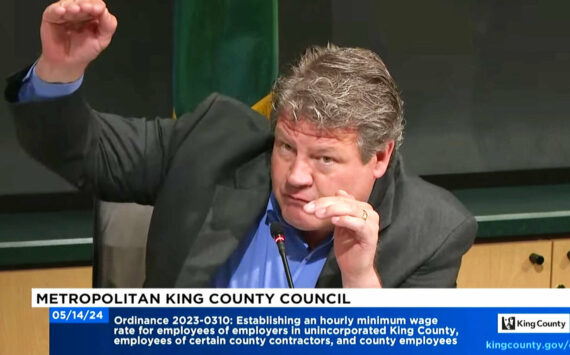IGGY POP screams “Lust for Life” on Royal Caribbean’s new TV commercial as rock climbers scale a wall and in-line skaters slide along the deck, busting the blue-haired, shuffleboard-playing image of the cruise ship tourist. Last week, as Royal Caribbean’s newest ship, “the 2,100 guest Radiance of the Seas,” prepared to make its maiden voyage out of Seattle, the liners were also trying to change impressions about the industry’s record of pollution.
Awaiting its trip to Victoria and Vancouver at Pier 66, the Radiance of the Seas—with its 13 enormous decks—dwarfs the nearby Edgewater Hotel. The swanky accommodations on the floating resort include a golf course, cinema, casino, gym, bank of computers, and mall of shops. The odor of ammonia wafts through the central lobby as 850 international crew members spit and polish the shiny surfaces and posh nautical decor.
The 2,100 travelers dine in nine restaurants and cafes and imbibe at another several bars and lounges. Twenty-four-hour room service is also available in the boat’s cabins.
Discreet “Save the Waves” signs ask patrons to refrain from throwing things off the decks. Waste bins ask people to sort their trash into bins marked paper, plastic, glass, or metals only. The Radiance boasts environmentally friendly measures, such as quiet gas turbine engines to reduce exhaust by up to 98 percent, a state-of-the-art waste management system, incinerators with emissions controls, and “storage capacity to maximize opportunities for recycling and use of shoreside treatment facilities.” Sounds good and green.
Yet underneath the smooth veneer of vacation luxury lurk toxic chemicals from services at the hair salon, photo lab, dry cleaners, and printing press, all of which generate hazardous materials. In addition, all the passengers and facilities produce an enormous amount of waste every week: 300,000 gallons of “blackwater” from toilets and oily bilge; a couple million gallons of “greywater” from showers, kitchen galleys, and laundry; and 50 tons of garbage. Will all this waste be disposed of properly?
Fred Fellerman, Northwest director of Ocean Advocates, is worried about pollution from cruise ships fouling Puget Sound. Consider the industry’s recent history: Just two years ago, Royal Caribbean had to cough up $18 million in criminal fines to the U.S. Justice Department for 21 felony counts, including expelling oily bilge water and falsifying records. Between 1993 and 1998, there were 104 incidents of pollution by various cruise lines, totaling $30 million in penalties. Currently, the U.S. Justice Department is investigating Norwegian and Carnival Cruises for environmental violations.
The industry says it has committed itself to improving its environmental practices. But critics also note that it is legal to dump greywater and treated blackwater in Puget Sound once the ships leave Elliott Bay. The cruise ships, however, have assured Washington’s Department of Ecology that sewage will not be dumped in our waters but discharged at sewage hookups in Vancouver, B.C. Unfortunately, that only begs the question as to why there are not sewage hookups at the Port of Seattle’s Bell Street Pier.
Last year’s local sailing season only had a few minor incidents of pollution. Washington’s Department of Ecology slapped “Notice of Violations” on several ships, mostly for not meeting refueling practices. The department also issued a notice of violation to Celebrity Cruises for painting a vessel at port from a float—a violation of the Port’s Best Management Practices. At the same time, a milky substance (not paint) of an unknown source was discovered.
Gov. Gary Locke has shown some interest in the issue of cruise ship pollution, but claims that the federal government’s Environmental Protection Agency prevents state and local authorities from regulating waters.
Government in Alaska, by contrast, has been much more proactive. Alaskan waters expect 650,000 cruise ship visitors from May to October. Last summer, led by local enviros and politicians, the State put cruise ships under scrutiny, testing waste-stream samples. Results were alarming. According to its Department of Environmental Conservation, the cruise ships’ wastewater was a stew of heavy metals and suspended solids. Tens of millions of colonies of fecal coliform were detected—well over effluence standards of 200 colonies for blackwater—and the amount of pollution in the ships’ greywater was as high as normally would be found in untreated sewage.
In response, U.S. Sen. Frank Murkowski (R-Alaska) pushed a bill through Congress last December prohibiting cruise vessels from discharging untreated sewage and requiring the Coast Guard to monitor waters to make sure they meet EPA standards. Also, for the first time, galley and shower waters will be regulated. Unfortunately, Murkowski’s bill only applies to Alaska’s waters, says Randy Ray, president of the U.S. Cruise Ship Association.
Ray, whose boats offer eco-tours for 30 to 235 passengers, says the pollution discovered in Alaska appears to be the result of malfunctioning or poorly maintained marine sanitation equipment.
The cruise industry says it intends to push technology to clean up waste-streams and plans to develop pilot programs to upgrade treatment systems.
After activist Fellerman visited the Radiance in Seattle, he remained unconvinced by the industry’s promises. He quips, “What a boat of glass. I guess they don’t throw stones, but they sure are crapping on our crabs.”






